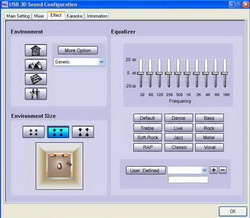Teac Headsets
2. TEAC HP-6D
The cheapest of the three, build on the C-Media CM108 USB Audio I/O controller, offers a virtual 5.1 surround This means that it does not literally have 6 channels, neither 6 speakers build in the headphones. However it does not have the effect of sound coming from the middle of your head either, thanks to a "virtual" surround ability. Of course the virtual surround is not anywhere near a real surround 5.1 home theatre / hi-fi but it does sound more interesting than the typical stereo setup. On the other hand, if you are not too keen on these fancy virtual stuff, then you can easily switch it to simple stereo mode, from the chipset's driver.
 |
 |
 |
Headphones connect to the computer via USB, hence do not interfere with any existing soundcard, cables etc. They appear under windows as an additional sound device, and applications (such as winamp, dvd players, etc) can be configured to use the headphones instead of the default playback/recording device. In addition, having a build in amplifier means that there is more than enough loudness available. The arm holding each speaker folds in two, allowing them to folding nicely in a compact shape.
I liked the fact that the headphones worked just fine upon first plug on windows XP SP2, without installing any drivers. Of course I later installed the drivers, in order to take full advantage of the features offered by the chipset.
The provided driver, on the 8cm CDROM does support karaoke - echo effect, on the mic input, as well as "pich" and "voice removal" but does not have the "monster, cartoon" effects of "magic software" (see HP-7D ) even though it mentions "magic voice software included" on the box. I tried to find a newer driver on the web that might include these cool monster/cartoon voice effects but had no luck.
The equalizer, unlike most cost efficient sound devices, can have a positive effect on the resulted sound (i.e. enhancing bass) without major distortion, and cropping that usually digital equalizers have. The microphone is build on the cable, and performs ok like most computer mics. +20dB boost is supported by the driver, hence voice capture is possible without having to swallow the mic, however you need to be careful when moving about cause pops and scratches will end quite loud.
The red power led is flashing when the USB is in use since it is not a good thing to unplug USB devices when USB communication takes place. The headphones look quite nice, feel very comfortable on the ears and offer a good environment noise isolation.
| USB DAC/Amplifier specifications | |
Chipset: |
C-Media CM108 |
Signal/noise ratio: |
>- 80dB |
Selection: |
>-60dB |
Distortion: |
< 0.5% |
Frequency range: |
20-20kHz |
| Headphone specifications | |
Speakers diameter: |
40 mm |
Impedance: |
64 Ohms |
Frequency range: |
20-20kHz |
| Microphone specifications | |
Type: |
Electret capuse 7mm Omnidirectional |
Impedance: |
2200 Ohms +/- 15% |
Sensitivity: |
60dB +/- 2 dB |
Frequency range: |
30 – 16kHz |
Sound: There is not much to say about the sound quality of these headphones. One should consider that they cost only about 20$ and include USB audio controller and mic, therefore do not expect anything impressive on the “speakers” side . However the speakers are not that bad and they do sound better than many similar priced. passive (without USB controller & amplifier) headphones available.
Overall grade: A-
Pros: Comfortable shape, decent sound for it’s price, mic, USB audio controller
Cons: Distortion at higher volume levels, no magic sound monster/cartoon effects



























